Energy efficiency is an important utility system resource that saves money for customers, generates jobs, and brings economic development to states. To capture these benefits, many states and utilities have developed energy efficiency programs, which are typically funded by ratepayers through a small fee—which we call an energy efficiency fee—that appears on their bills or is embedded in their rates. Fees are then aggregated to fund cost-effective energy efficiency programs and projects.
Self-direct energy efficiency programs let some customers, usually large industrial or commercial ones, direct their fees toward energy efficiency investments at their own facilities rather than putting them into a broader aggregated pool of funds. Well-structured self-direct programs offer large energy users greater flexibility and control over their fees, while ensuring that measurable, cost-effective energy savings are achieved for all customers in the utility system.
This toolkit briefly discusses best practices, program examples, and model language for developing self-direct programs. Our objective is to provide examples of program approaches so that stakeholders can more easily evaluate the opportunities and challenges of self-direct program designs and identify a model that might work well in their state.
Introduction
Like other utility system resources, energy efficiency is a resource that can benefit all users and should be paid for by all users. However, some industrial and large commercial customers contend that they should not have to pay energy efficiency fees. They ask to be exempted from energy efficiency programming for a variety of reasons—one of the most common being that they already invest in all cost-effective energy efficiency on their own, as a matter of good business practice. However this claim is unlikely to hold true since energy efficiency programming typically uses a less conservative financial test to determine which efficiency measures are funded than an individual company would. In addition, more measures can be carried out through program participation, since programs help provide shorter payback periods for investments and include access to technical assistance and engineering expertise that is not otherwise available. (For more information on this and related issues, see Myths and Facts about Industrial Opt-Out Provisions.)
To address these concerns about the value of paying into energy efficiency programming, many states are seeking new and improved ways to reach out to their largest energy users. A report from the State and Local Energy Efficiency Action Network, Industrial Energy Efficiency: Designing Effective State Programs for the Industrial Sector, summarizes good strategies for engaging large customers, including a chapter on self-direct. Several states have implemented self-direct programs, which can be an effective tool for delivering energy savings in a way that is more responsive to the needs of large energy users. As of January 2017, Arizona, Colorado, Idaho, Michigan, Minnesota, Montana, New Jersey, New Mexico, New York, Oregon, Vermont, Washington, and Wisconsin offer self-direct programs for large customers.
These self-direct programs operate differently from state to state. The best examples are highly structured, include substantial oversight, and are capable of achieving documented energy savings equivalent to what would have been saved through participation in traditional program offerings. Bear in mind, however, that not all self-direct programs are effective alternatives to traditional program offerings. Some self-direct programs happen entirely outside of utility programming and do not deliver documented energy savings. These programs might be called self-direct, but as we now describe, they function more like opt-out provisions.
Distinguishing Between Self-Direct and Opt-Out
Opt-out provisions allow large customers a full exception from paying energy efficiency fees; unlike self-direct programs, opt-out has no corresponding obligation for the company to make energy efficiency investments on its own. Most opt-out provisions let large customers stop participating in utility programs if they choose. Some state policies eliminate that option, exempting a class of customers from efficiency programs altogether. Opt-out provisions and exemptions can preclude utilities from incentivizing energy savings and from counting or measuring any efficiency that opting-out customers achieve on their own. In contrast, good self-direct programs typically require customers to make their own cost-effective energy efficiency investments, and program administrators measure and verify energy efficiency savings.
Self-direct programs allow large customers to control how some or all of their energy efficiency fees are used, but do not allow them to opt out of fees and programs completely.
Opt-out provisions allow large customers to stop contributing funding for energy efficiency programs, and may prevent utilities from incentivizing, measuring, or otherwise accounting for these savings in resource planning efforts.
Allowing large customers to opt out of energy efficiency fees or to self-direct their funds without substantial oversight by regulators or adherence to cost-effectiveness tests is unfair to other customers, who benefit from energy efficiency investments made anywhere in the system. The industrial sector offers some of the most cost-effective energy efficiency available, and states that work to capture that potential are best positioned to deliver the benefits of energy efficiency to all customers. (For more information on industrial energy efficiency’s benefits, see ACEEE’s fact sheet, “Industrial Efficiency Programs Can Achieve Large Savings at a Low Cost.”) It is critical, then, that state regulators and policymakers, as representatives working on behalf of all of a state’s residents, ensure that well-functioning programs are available for large energy users.
Self-direct programs are typically designed by utilities in collaboration with their regulatory agency, although legislative bodies sometimes dictate how programs are to be structured. Opt-out provisions tend to be enacted through legislation, but no one model prevails. ACEEE’s State and Local Policy Database offers details of every known opt-out or self-direct program currently operating in the United States. Because opt-out provisions are not tools for capturing energy efficiency, we offer no further discussion of them here.
Self-Direct Program Elements
Self-direct programs can be structured to serve the public interest by yielding cost-effective energy savings, while also offering flexibility to help the industrial sector overcome long-standing barriers to greater energy efficiency. These programs can serve a state or utility system well when coupled with oversight and verification of claimed savings. Self-direct programs come in many different flavors, but generally have at least the following four elements:
- They define who is eligible. Eligibility is typically defined by setting an annual kilowatt-hour consumption minimum or average megawatt demand minimum for electricity or, for natural gas, an annual usage of therms. Some programs establish an entire sector or tariff schedule as eligible—such as industrial or transmission customers, who usually represent the largest energy demand.
- They offer some relief from energy efficiency fees. Relief from fees can come in the form of a rebate against, escrow of, bill credit to, or exemption from the energy efficiency fees paid by the participating customer.
- They are officially sanctioned and administered. Programs are administered by a formal entity such as a utility, public service commission, or other state agency with the ability to provide oversight.
- They expect energy savings. In return for relief from fees, programs require the participating customer to invest some or all of the saved money back into energy efficiency projects on site, with an expectation of savings beyond business as usual.
Self-Direct Best Practices
In addition to the common program elements described above, self-direct program design includes several best practices that contribute to successful outcomes. In general, best practice self-direct programs
- Are treated as part of a larger portfolio of utility program offerings. Self-direct programs focus on energy savings, rather than funds spent, and report these savings to regulators. Routine data collection, standard approaches to measuring and verifying energy savings, and regular progress reporting are required so as to count savings toward the utility’s savings goals and include them in long-term resource planning. When new self-direct programs are developed, they should not allow credit for efficiency investments made prior to the program’s commencement.
- Establish a transparent mechanism for customers to manage their individual fee contributions and apply funds toward their projects. Customers can access their fees through mechanisms such as dedicated escrow-like accounts, rebates earned upon project completion, or rate credits earned concurrently with energy efficiency investments and/or energy savings. A portion of the fees is retained to contribute to the cost of program administration. Any fees unused at the end of the program cycle are made available to other eligible customers for cost-effective projects.
- Provide customers with greater flexibility and control over their energy efficiency funds. Self-direct programs allow multiyear time frames (e.g., four years); this lets customers spend aggregated energy efficiency fees and gives them flexibility regarding eligible technologies and projects. Engaging large customers in the design and development of self-direct programs ensures that the program’s administration, implementation, and evaluation are responsive to large customers’ needs.
- Are structured to ensure wise spending of energy efficiency funds. Self-direct programs yield cost-effective savings, and administrators can develop reliable accounts of the cost of the program’s saved energy. Programs may employ the same cost-effectiveness tests and standards of measurement and verification (M&V) as other fee-supported programs, or they may develop and commit to individually defined approaches. If it is determined that a company claimed savings erroneously or forecasted savings that did not actually occur, a mechanism must be in place to recoup funds or disqualify the customer from participation.
Examples of Self-Direct Programs
The following descriptions summarize some examples of well-structured self-direct programs in the United States. These programs feature most of the best practices listed above, and all of them have participating customers doing their part to help acquire cost-effective energy efficiency for all system users.
New Jersey Large Energy Users Program
In New Jersey, the Large Energy Users Program is managed by TRC, a contractor to the energy efficiency fee-funded New Jersey Clean Energy Program (NJCEP). To qualify for the self-direct program, which originally launched as a pilot in 2011, eligible customers must have contributed at least $300,000 in energy efficiency fee funds during the previous fiscal year. Customers can aggregate multiple buildings or sites together to meet the threshold. In addition, the facilities must have a total annual billed peak demand of 400 kW or greater to ensure projects are large enough, since the program was designed for only the state’s largest commercial and industrial customers.
As part of the enrollment process, the program calculates the amount of funding each participant previously contributed toward NJCEP through its energy efficiency fees and reserves that amount for use as a grant toward future energy efficiency investment. Within 90 days of enrollment, participants submit a Draft Energy Efficiency Plan (DEEP) that gives the program an overview of the proposed project and serves a basis for reserving incentives. Once the DEEP is approved, the customer has 90 days to complete a more detailed Final Energy Efficiency Plan (FEEP), which must incorporate M&V procedures and be certified by a professional engineer.
The incentive structure returns 90% of a participant’s NJCEP fund contribution from the previous fiscal year, unless that amount exceeds 75% of total project costs or $0.33 per projected kWh savings. Incentives are paid once the customer submits proof of having completed the measures, including invoices for materials/labor costs, work orders, a completed M&V report certified by a professional engineer, a certificate of compliance with the prevailing wage, and any differences between the project as completed and the FEEP description. If necessary, customers may be granted a six-month extension to install the measure(s).
Since the pilot, the program has been modified and updated to improve flexibility and respond to feedback from large customers. These changes included increasing the calculated customer contribution, which allows customers access to more funding; eliminating a requirement that projects achieve an eight-year simple payback or 10% internal rate of return; and moving from a 45-day enrollment window to a rolling enrollment schedule. These changes have improved customer satisfaction, as well as access to cost-effective energy savings for the state of New Jersey.
Puget Sound Energy
The Puget Sound Energy (PSE) Large Power User Self-Directed program is unique in the country in that it is a long-term initiative (spanning four years) and uses a dedicated escrow-like account to provide incentives based on customer contributions, with a competitive bidding process for unclaimed funds. Companies that take service from PSE under several rate schedules may be eligible for the self-direct program; most are automatically enrolled if they take three-phase service at greater than 50,000 volts. Currently, about 90% of eligible customers are working with PSE to develop and complete energy efficiency projects through the self-direct program.
Self-direct customers continue to pay their energy efficiency fee, but PSE tracks individual customer contributions for their specific use. Customers have access to 82.5% of their fees. PSE retains 7.5% for program administration and 10% to fund the Northwest Energy Efficiency Alliance’s market transformation activities. While participants in other PSE commercial and industrial programs are limited to maximum incentives of 70% of measure cost, self-direct customers may fund up to 100% of measure cost.
After an initial noncompetitive phase (e.g., 24 months) in a program cycle, all unused funds are pooled together into a program-wide pool, and PSE issues a competitive RFP for program-eligible customers to compete for those funds. The projects funded as a result of this competitive bid process are generally more cost-effective than those funded during the first two years, as customers compete against each other to make a case for their projects.
All projects must meet PSE’s avoided cost requirements and include an agreed upon M&V plan. Upon approval, PSE enters into a funding allocation agreement with the company and conducts a post-installation inspection after the measure is implemented.
New York
A self-direct program was introduced within New York’s Reforming the Energy Vision (REV) initiative through a 2015 Commission Order requiring all six utilities to implement a self-direct program for large energy users by January 1, 2017. The program structure incorporates key elements such as a long-term program cycle and a dedicated escrow-like account for managing customer funds. It also targets unused funding toward projects in areas where efficiency can help defer load through a competitive bid process. During the first opportunity to enroll in the current program, customer interest varied.
To be eligible for the self-direct program, individual customers must have a 36-month average demand of 2 MW or greater. Customers with an aggregated 36-month average demand of 4 MW or greater will also be eligible if one or more of the accounts being aggregated has at least a 36-month average demand of 1 MW. Upon enrollment, participants are assigned an Energy Savings Account (ESA) to collect their fee contributions for efficiency assessed on their utility bill, which would otherwise be allocated to the general pool for utility-administered energy efficiency programs. The utility manages the ESA and may retain up to 15% for program administration and M&V.
The program runs on a three-year cycle, and participants will have access to at least 85% of their energy efficiency fee contributions to fund eligible projects during that time. Before projects are implemented, participants provide a Project Plan—including details on expected costs, savings, baseline calculation, M&V plan, and schedule—for the utility to review and approve. To access funds, customers submit proof of payment and/or invoices and receive a reimbursement check for expenses associated with their projects. At the end of the cycle, any unused funds are pooled and the utility will accept competitive bids for the funds from program participants or third parties with efficiency projects located in areas targeted for load deferral.
The self-direct program is expected to achieve savings at a lower cost than a traditional energy efficiency program. As part of the enrollment process, participants and utilities commit to achieving savings at or below an agreed upon and committed dollar-per-MWh, which must be at least 7.5% less than the utility’s approved portfolio-level dollar-per-MWh. Projects must also pass a cost-benefit test, and energy savings from self-direct projects can count toward a utility’s savings goals.
Xcel Energy
In Colorado, Xcel Energy runs its self-direct program like any other demand-side management (DSM) program offering. The same staff offers custom, prescriptive, and self-direct programs to industrial and large commercial customers with an aggregated peak load of at least 2 MW in any single month and annual consumption of at least 10 GWh. Although several hundred customers are large enough to qualify, Xcel estimates that five customers will participate in 2017 and 2018 based on its current project pipeline and historical participation.
Self-direct customers continue to pay their assigned energy efficiency fee, and self-direct projects are reimbursed through a rebate. The first step to participation is prequalification. Next, the customer identifies a project and submits a proposal for review. Xcel provides the customer with preapproval or denial, including the estimated rebate, estimated energy savings, and an agreed upon M&V plan. Customers have two years to complete the project and submit a final report once the project is operational to earn their rebate check. Customers can earn rebates of up to 50% of the incremental project costs, either $525 per kW or 10 cents per kWh.
The primary factor differentiating the self-direct from the custom program is that, in the self-direct program, the customer performs all of the work and incurs all the costs for a project’s identification study, design, engineering, M&V, and reporting. The customer also has access to a more generous rebate than is available through the custom program. Large customers with the resources to manage this work choose to participate in the self-direct program because it lets them perform the administrative and engineering activities on their own and enjoy the higher rebate.
Xcel Energy holds its self-direct customers to the same cost-effectiveness tests as any of its other efficiency customers. Participants in the self-direct program can participate in other DSM program offerings, but they cannot use traditional DSM programs in conjunction with the self-direct program for the same project. Additionally, rebates are offered for identifying potential new projects only through the traditional DSM programming. A similar self-direct option is available to customers of Xcel Energy in Minnesota, but none have pursued participation beyond initial discussions.


